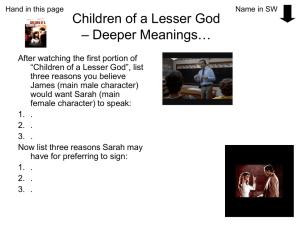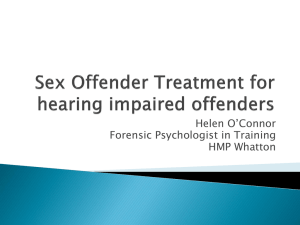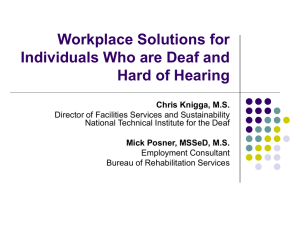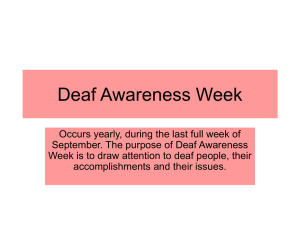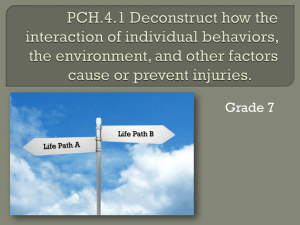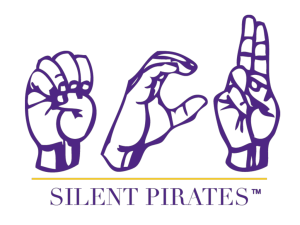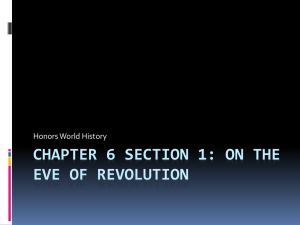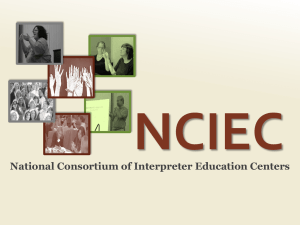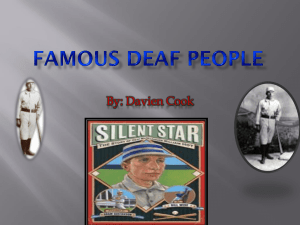Overcoming Unintentional Audism
advertisement
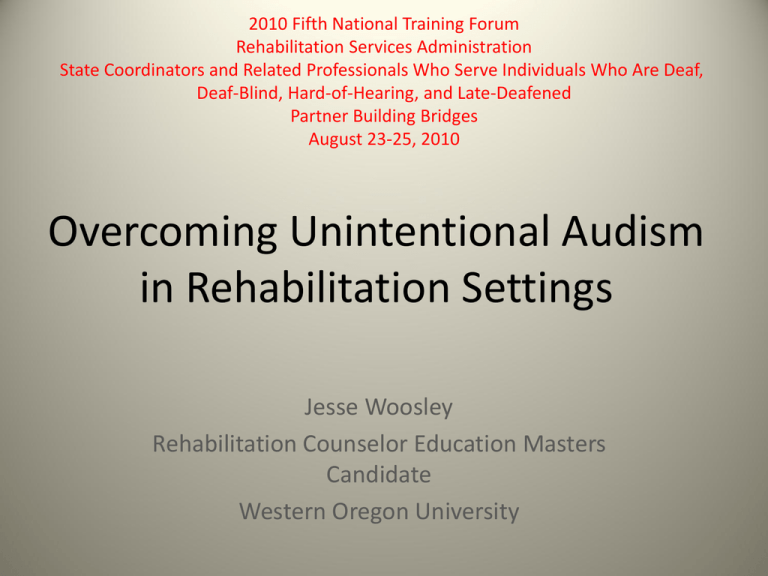
2010 Fifth National Training Forum Rehabilitation Services Administration State Coordinators and Related Professionals Who Serve Individuals Who Are Deaf, Deaf-Blind, Hard-of-Hearing, and Late-Deafened Partner Building Bridges August 23-25, 2010 Overcoming Unintentional Audism in Rehabilitation Settings Jesse Woosley Rehabilitation Counselor Education Masters Candidate Western Oregon University Agenda • Presentation on Overcoming Unintentional Audism in Rehabilitation Settings • Reflection Activity • “Audism Unveiled” movie/discussion Overcoming Unintentional Audism in Rehabilitation Settings Outline: • A history of audism • Identifying unintentional audism • Overcoming unintentional audism A History of Audism • Ages old phenomenon – Strong connection between hearing and speaking language ability to identity of human race “How dull they are in general. How little do they differ from animals.”- J.C. Amann “human in shape, but only half human in attributes” –L.Dudley “a perfect non-entity, a living automaton...” A. Sicard “to be human was to speak. To sign was a step downward in the scale of being.”- D. Baynton Bauman (2004) A History of Audism • First usage of term “audism” – Coined by Dr. Tom Humphries, 1977: Communicating Across Cultures (Deaf/Hearing) and Language Learning – Audism: The notion that one is superior based on one’s ability to hear or behave in the manner of one who hears. – System of privilege based on ability to hear A History of Audism • “It’s just another –ism” – Validation – Recognizing audism helps resist audist behavior and practice, whether intentional or not A History of Audism • Creating the future: – Increased awareness of unintentional audism enhances service to deaf and hard-of-hearing populations – How can rehabilitation professionals contribute? Identifying Unintentional Audism • Audism and Unintentional Audism: What’s the difference? – Unintentional audism is often overlooked and the more prevalent type of audism. – Audism is the more obvious form of oppression with malicious intentions. Identifying Unintentional Audism • What are some examples of unintentional audism? -Looking away or mumbling while talking to a person who lip reads -Avoiding to make eye contact with deaf or hard-of-hearing person -Passing up opportunity to learn and use sign language -Not enough lighting in room -Raising voice at the person -Stereotyping or making assumptions -Talking to interpreter instead of directly at client Identifying Unintentional Audism • Possible causes of unintentional audism: – – – – – Good intentions/ bad interventions Traditional training Cultural tunnel vision Blaming the victim Either/or thinking • How good intentions may be harmful: – Unwillingness of professional to critically examine one’s own actions Ridley (2005) Identifying Unintentional Audism • Personal bias, preconceived notions and assumptions: – We are not taught to recognize hearing privilege – Often the advantages of hearing privilege is taken for granted. – Expectations that “they” should be more like “us” Overcoming Unintentional Audism • Examining one’s own privilege -White privilege: Unpacking the invisible knapsack by Peggy McIntosh “As a white person, I realized I had been taught about racism as something that puts others at a disadvantage, but had been taught not to see one of its corollary aspects, white privilege, which puts me at an advantage.” Overcoming Unintentional Audism • Taking the initial steps: -Power to make positive changes for deaf and hard-of-hearing people often lies in the hands of people who have hearing privilege -Unacknowledged hearing privilege and audism can contribute to phenomenon of “invisible oppression” (McIntosh, 1988) Overcoming Unintentional Audism • Recognizing microaggressions: -”subtle in nature and can be manifested in the verbal, non-verbal, visual or behavioral realm” -often subconscious and conditioned behavior (Sue and Sue, 2008) Overcoming Unintentional Audism • Awareness or “critical consciousness” -Vital to make changes happen -Willingness of professional to participate in difficult dialogues about audism with peers, clients, and others. -Recognize and confront typical defense mechanisms that privileged individuals may use (Watt, Curtis, Drummond, Kellogg, Lozano, Nicoli, & Rosas, 2009) Reflection • How can you share hearing privilege or “power” with deaf and hard-of-hearing individuals? • What were your experiences with “unintentional audism” like? • What direction should we take with our awareness of “unintentional audism”? Movie • “Audism Unveiled” References • • • • • • • • • • Bauman, D.L. (2004). Audism: Exploring the Metaphysics of Oppression. Journal of Deaf Studies and Deaf Education, 9, 239-246. Chaney, M.P., Foley, P.F., and Smith, L. (2008). Addressing classism, ableism, and heterosexism in counselor education. Journal of Counseling and Development, 86, 303-309. Curtis, G.C., Jerri Drummond, J., Kellogg A.H., Lozano, A., Nicoli, G.T., Rosas, M., and Watt, S.K. (2009) Counselor preparation, privileged identity exploration: Examining counselor trainees’ reactions to difficult dialogues. Counselor Education and Supervision, 49, 86-105. • • Harrington, T. (2009) FAQ: Audism. retrieved from http://library.gallaudet.edu/Library/Deaf_Research_Help/Frequently_Asked_Ques tions_%28FAQs%29/Cultural_Social_Medical/Audism.html • • • • • • • • • • • • • MacIntosh, P. (1988). White privilege and male privilege: A personal account of coming to see correspondences through work in Women's Studies. Wellesley, MA: Center for Research on Women, Working Paper Series, no. 189. Peters, S. W. (2007) Cultural awareness: enhancing counselor understanding, sensitivity, and effectiveness with clients who are deaf. Journal of Multicultural Counseling and Development, 35, 182-190. Ridley, C. (2005) Overcoming Unintentional Racism in Counseling and Therapy. Thousand Oaks, CA: Sage Publications Sue D. & Sue D.W. (2008) Counseling the Culturally Diverse. Hoboken, N.J.: John Wiley & Sons, Inc.
